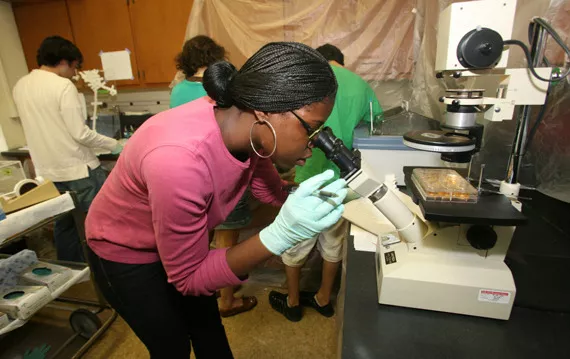Swarthmore College Praised for Science and Technology Success

The Council of Independent Colleges lauds Swarthmore College's achievements in science, technology, engineering, and mathematics (STEM) in a recent study entitled "Strengthening the STEM Pipeline: The Contributions of Small and Mid-Sized Independent Colleges."
The study finds that many small and mid-sized independent institutions such as Swarthmore contribute disproportionately to fortifying the American workforce in the science and technology fields. It ranked Swarthmore highly in four fields in particular:
- Physics, in which 45 percent of Swarthmore graduates between 2001 and 2005 went on to earn a Ph.D. in physics by 2010, a higher percentage than that of any other institution;
- Biological sciences, in which one out of every four Swarthmore graduates (from a total undergraduate enrollment pool of 1,500) went on to earn a Ph.D., a higher rate than that of the large public research universities in Pennsylvania;
- Computer science, in which Swarthmore produced the same number of graduates who went on to receive doctorates as did much larger research universities such as the University of Houston (27,048 total undergraduates) and the University of Tennessee (19,224); and
- Mathematics and statistics, for which Swarthmore produced the same amount of graduates who went on to complete a Ph.D. between 2006 and 2010 as did the in-state flagship Pennsylvania State University. Swarthmore students were also more than six times as likely to complete their doctoral degrees.
The sciences are well represented on the steering committee of The Frank Aydelotte Foundation for the Advancement of the Liberal Arts and the expanding science faculty fills leadership roles in interdisciplinary programs throughout cognitive science, environmental studies, and gender and sexuality studies. Swarthmore is also expressing its commitment tangibly with the largest building project in its history, which will create a new home for the biology, engineering, and psychology departments and foster greater synergy among students and faculty.
These findings echo those of the National Science Foundation, which found last year that Swarthmore has the highest rate of production of doctorate recipients in the social sciences in the United States. The same study showed that Swarthmore is also among the top five highest producers of doctorate recipients in the humanities, life sciences, and all sciences combined, with 20 percent of Swarthmore graduates going on to earn a doctorate degree.



